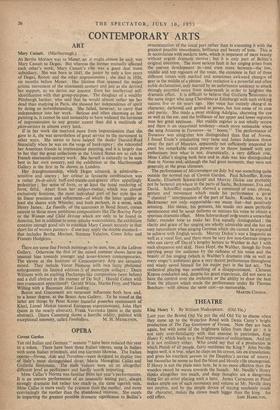CONTEMPORARY ARTS
ART
As Berthe Morisot was to Manet, so it might almost be said, was Mary Cassatt to Degas. But whereas the former mutually affected each other's work, Mary Cassatt's role was a good deal more subsidiary. She was born in 1845, the junior by only a few years of Degas, Renoir and the other impressionists ; she died in 1926, six months before Monet. Her lifetime thus spanned the major artistic movement of the nineteenth century and just as she derived her support, so we derive our interest from her intellectual self- identification with that group-purpose. The daughter of a wealthy Pittsburgh banker, who said that he would alenost rather see her dead than studying in Paris, she showed her independence of spirit by doing so notwithstanding. She failed, however, to carry that independence into her work. Serious and often charming as her painting is, it cannot be said noticeably to have widened the horizons of impressionism to any greater extent than did a multitude of plein-airistes in almost every land.
If in her work she received more from impressionism than she gave to it, she was nevertheless of great service to the movement in other ways. She seems to have helped the dealer Durand-Ruel financially when he was on the verge of bankruptcy ; she interested her American friends in impressionist painting, and it is largely due to her that the great collections in the United States are so rich in French nineteenth-century work. She herself is naturally to be seen best in her own country, and the exhibition at the Marlborough Gallery is the first to be shown in London.
Her draughtsmanship, which Degas admired, is admirable-- sensitive and sinewy ; her colour (a favourite combination was a rather fin-de-siecle buff-and-purple-and-green) often appallingly pedestrian ; her sense of form, or at least the tonal rendering of form, fitful. Apart from her subject-matter, which was almost exclusively feminine, the most individual part of her style lies in its linear precision and refinement—of which the latter quality at least she shares with Whistler, and both perhaps, in a sense, with Henry James. La Famille, of the canvasses in Bond Street, comes nearest to those more ambitious compositions like The Boating Party or the Woman and Child Driving which are only to be found in America, but in addition to some splashy watercolours, the exhibition contains enough good oils to establish Mary Cassatt securely in that short list of women painters—if one may apply the double standard— that includes Berthe Morisot, Suzanne Valadon, Gwen John and Frances Hodgkins.
There are some fine French paintings to be seen, too, at the Lefevre Gallery. Otherwise the first of the mixed summer shows have an unusual bias towards younger and lesser-known contemporaries. The eleven at the Institute• of Contemporary Arts are certainly mixed. They include Victor Pasmore with two fuzzy photostat enlargements (in limited editions !) of monotype collages ; Denis Williams with an exciting Duchamps-like composition (seen before) and a dull abstract in the manner of De Stijl ; Harold Cohen with two evanescent apparitions'; Gerald Wilde, Martin Froy, and Victor Willing with a Baconian Man Looking.
Bacon and Giacometti are recurrent influences both here and, to a lesser degree, at the Beaux Arts Gallery. To be noted at the latter are things by Peter Kaiser (tasteful gouaches reminiscent of Klee), Lionel Miskin (central European expressionism), John Hart (paint in the nearly abstract), Frank Vavruska (paint in the quite abstract). Diana Cumming shows a horrific oddity, painted with exceptional intensity, called Footballers. M. H. MIDDLETON.


































 Previous page
Previous page